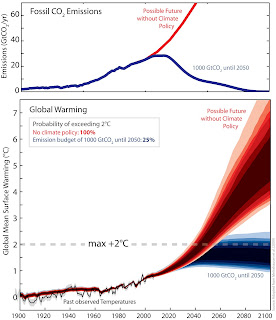.
Cover of the current edition of 'Nature'. Credits: 'Nature'
Less than a quarter of the proven fossil fuel reserves can be burnt and emitted between now and 2050, if global warming is to be limited to two degrees Celsius (2°C).
The study has, for the first time, calculated how much greenhouse gas emissions we can pump into the atmosphere between now and 2050, to have a reasonable chance of keeping warming lower than 2°C (above pre-industrial levels) – a goal supported by more than 100 countries (2). We can only emit 1000 billion tonnes of carbon dioxide (CO2) between the years 2000 and 2050. The world has already emitted one third of that in just nine years.
“If we continue burning fossil fuels as we do, we will have exhausted the carbon budget in merely 20 years, and global warming will go well beyond two degrees,” says Malte Meinshausen, lead author of the study and climate researcher at the Potsdam Institute for Climate Impact Research. The three-year research project involved scientists from Germany, the United Kingdom and Switzerland (3).
The study concluded that greenhouse gas emissions must be cut by more than 50 percent by 2050 relative to 1990 levels, if the risk of exceeding 2°C is to be limited to 25 percent.
“Only a fast switch away from fossil fuels will give us a reasonable chance to avoid considerable warming. We shouldn’t forget that a 2°C global mean warming would take us far beyond the natural temperature variations that life on Earth has experienced since we humans have been around,” says Malte Meinshausen.
The study also compared the volume of CO2 emissions that could result from the burning of known economically recoverable fossil fuel reserves—oil, gas and coal—and found that these reserves are four times larger than the emission budget between now and 2050 (4). “To keep warming below 2°C, we cannot burn and emit the CO2 from more than a quarter of the economically recoverable fossil fuels up to 2050, and in the end only a small fraction of all known fossil fuel reserves,” concludes Bill Hare, co-author of the study.

Two possible futures: One in which no climate policies are implemented (red), and one with strong action to mitigate emissions (blue). Shown are fossil CO2 emissions (top panel) and corresponding global warming (bottom panel). The shown mitigation pathway limits fossil and land-use related CO2 emissions to 1000 billion tonnes CO2 over the first half of the 21st century with near-zero net emissions thereafter. Greenhouse gas emissions of this pathway in year 2050 are ~70% below 1990 levels. Without climate policies, global warming will cross 2°C by the middle of the century. Strong mitigation actions according to the blue route would limit the risk of exceeding 2°C to 25%. For more details, see Figure 2 in Meinshausen et al. (2009).
Credit: M. Meinshausen et al. (2009)
** If you enjoyed this post please also check out:
.
Gambling with climate change
.
Americans and climate change
.
Splitting: 'jobs' versus 'the environment'.
COMMENTS ALWAYS WELCOME !!
.
So please, tell us what you think.













